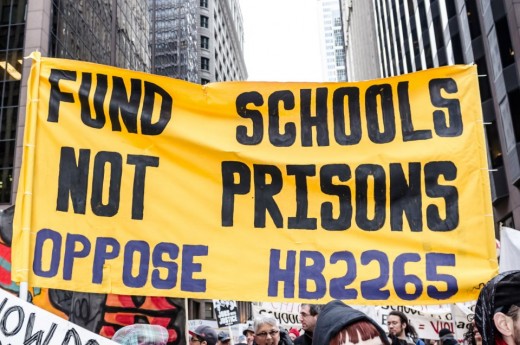Guest Post: Fund Schools Not Jails! by Erica Meiners
Fund Schools Not Jails!
March 27, 2013
Erica R. Meiners is a Professor of Gender and Women’s Studies and Education at Northeastern Illinois University. She is the author of Right to be hostile: schools, prisons and the making of public enemies (2009) and articles exploring the school to prison pipeline. She is a member of her labor union, University Professionals of Illinois, and actively involved in a number of non-traditional and popular education projects including an anti-prison teaching collective (Chicago PIC Teaching Collective) and the Chicagoland Researchers and Advocates for Transformative Education (CReATE) and she is currently teaching classes at Stateville Prison and St. Leonard’s Adult High School.
Thousands of people converged downtown today to speak back to Chicago’s unelected school board against the proposed closure of fifty-four public schools in Black neighborhoods. Amidst the colorful and pithy signs held up by teachers, parents, and young people my favorite (topping even the signs from the fall 2012 Chicago Teacher’s Union strike proclaiming Rahm loves Nickelback) was Fund Schools Not Jails!
While it might appear that the struggle to shutter our prisons, to decriminalize marijuana and sex work, or to release people from prison early on “good time,” is disconnected from the fight to keep open and fully funded high quality neighborhood schools in Black communities, the two are intimately linked.
Illinois, similar to many other states, built over twenty-five new prisons or other detention facilities between 1985 and 2005 and no new public colleges or universities. Funding reform initiatives for K-12 education, mandated by the Illinois State Supreme Court, have stalled for decades ensuring that poor and/or communities of color still receive significantly less money. State contributions for public colleges and universities stagnate, erode and/or are tied to punitive accountability regimes, while budget lines for incarceration and policing mount.
As today’s signs and speeches forcefully outlined, closing schools not will not only prove costly for Chicago Public Schools, but these acts destabilize communities, sever relationships between adults and youth, and push young people into unfamiliar and potentially dangerous contexts (also to schools that might not be academically any stronger including charter schools that hire non-union teachers).
Beyond identifying school closure as a public safety problem, Fund Schools Not Jails! names the well resourced public institutions that are ready and waiting to enclose Black and/or poor communities. In 2013, Illinois will pay $74,697 to warehouse a youth at the prison in Warrenville, and only $6,119 to fund public K-12 education. There is no money to support schools in Black communities across Chicago, but the state finds the funds to run a network of prisons across Illinois that capture people from the south and west side of Chicago.
Divestment in public education while investing in prisons destabilizes schools and communities and enhances the school to prison pipeline. The people I teach at St. Leonard’s Adult High School (a program for formerly incarcerated men and women), and at Stateville Prison, have been pushed out of free world formal education. (According to the Bureau of Justice Statistics, approximately 63% of those in state prisons have not earned a high school diploma). Lack of education (especially a high school diploma) increases the likelihood of imprisonment, so much so that some social scientists identify imprisonment as a “life-stage” event, like marriage or the military, for low-income Black men. Even after people are released from prison, formal and informal barriers to employment, social services, and housing make it almost impossible for people to rebuild a life.
In the wake of the death of Hadiya Pendleton and the school shootings in Newtown, Connecticut, people are grappling with how to feel and to be safe. But in our struggles to build safer and stronger communities, we must place high quality neighborhood schools for all at the center, and not be swayed by the false promise that increased militarization and criminalization will make our communities strong.
We know what will not work: South Dakota’s turn to arm teachers and other school personnel with guns. Closer to home, the move by Chicago’s Alderman Roberto Maldonado, without a community process or support, who aims to convert Ames Middle School into a military school. Mayor Rahm Emmanuel’s support of HB2265 (SB1003), a bill to increase mandatory minimum sentences for unlawful use of a weapon that abysmally fails to address the roots of gun violence and will instead spike the prison population by nearly 4000 in the next decade, for no public safety gain. These initiatives divert resources away from the common good, and do not make our schools, or our communities, safer.
We are the nation with the largest prison population on the planet, where one in three people lives at or near federal poverty levels, and too many are left behind and locked out of access to high quality public education, including those who are Black and Brown and/or non heterosexual or gender conforming.
Fund Schools Not Jails! demands we do what we must: shrink our prison nation, reinvest in our public schools, and collectively reclaim and rebuild real forms of community public safety.
Note from Prison Culture: Please take 5 minutes to call your legislators TODAY to say NO to HB2265/SB1003 and Yes to high quality public education. If you live in IL, you can find your legislators here.

